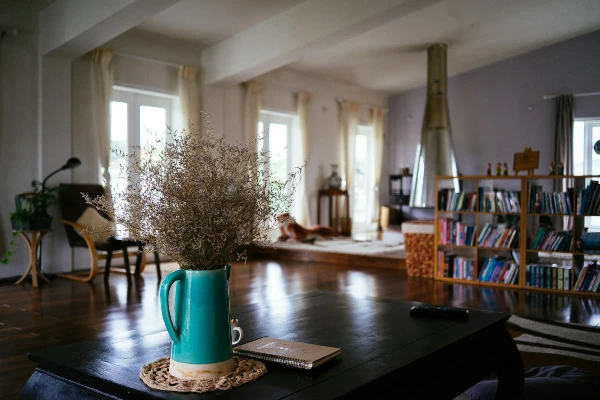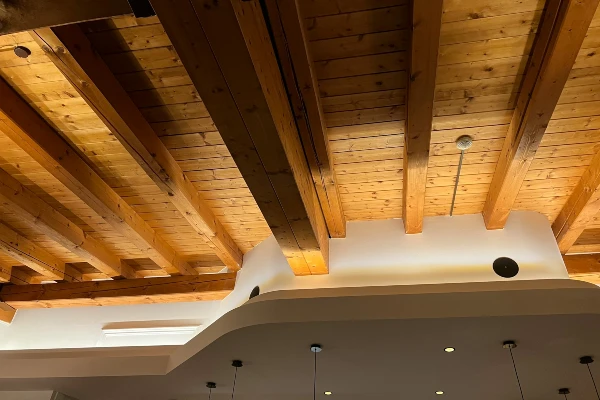Disclosure: This post may contain affiliate links, meaning we get a commission if you decide to make a purchase through our links, at no cost to you. Please read our disclosure for more info.
In recent times, black-out curtains have surged in popularity for their capability to block light from the outside, enhance privacy, and promote an intimate feeling. These curtains should be the perfect solution for you whether you are a night worker yearning for total darkness in the daytime or just want to glare-proof your living room.
But do blackout curtains really work? Can they really block out light, noise, and heat transfer? This guide will explain the science behind blackout curtains and how effective they are, alongside their advantages and some disadvantages.
In This Post:
1. How Do Blackout Curtains Work?
Blackout curtains are generally made from layers of tightly woven cloth, making it possible to block light at a maximum level from entering a room. They often come with:
- Triple-weave fabric technology – Enhances light blocking and insulation.
- Foam or thermal backing – Helps with noise reduction and temperature control.
- Heavy materials – Prevents light from seeping through gaps.
Blackout drapes, in contrast to those ordinary drapes which filter but never completely block light, do absorb and bend rays of light, thus keeping the room darker as compared to using normal curtains.
2. Key Benefits of Blackout Curtains
1. Light Blocking – Perfect for Bedrooms and Home Theaters
The major advantage of blackout curtains is keeping out sunlight and other light and can significantly reduce brightness by 90-100% thus are suitable for.
-
- Bedrooms (especially for light-sensitive sleepers).
- Nurseries (helping babies and young children sleep better).
- Home theaters (enhancing movie-watching experiences).
- Offices (reducing glare on screens).
2. Privacy Protection – Keep Prying Eyes Out
Blackout curtains are literally thick kinds of virtually opaque fabric, rendering them perfect for:
- Apartments in busy neighborhoods.
- Ground-floor bedrooms or living rooms.
- Homes near streetlights or bright city areas.
3. Energy Efficiency – Reduce Heating and Cooling Costs
Blackout curtains can help maintain indoor temperatures by:
- Blocking heat in summer – Keeps your home cooler by preventing direct sunlight.
- Retaining warmth in winter – Acts as an insulating layer, reducing heat loss.
Some studies indicate that there can be energy savings of 10-25% per annum with black-out, thermal curtains.
4. Noise Reduction – A Quieter Environment
Thicker blackout curtains can absorb some external noise, making them useful for:
- Homes near busy streets or airports.
- Apartments with noisy neighbors.
- Creating a more peaceful sleep environment.
But they won’t stop all the noise. Most of these damper mats claim to “reduce sound penetration by 20 – 40%“.
5. Improved Sleep Quality – Ideal for Shift Workers and Light Sleepers
If you work night shifts or suffer from light sensitivity, blackout curtains can help regulate your sleep cycle by:
- Creating a dark, sleep-friendly environment.
- Preventing early morning sunlight from waking you up.
- Supporting melatonin production (the sleep hormone).
3. Do Blackout Curtains Have Any Downsides?
While blackout curtains offer many benefits, they also have a few potential drawbacks:
1. Limited Natural Light
If used in living spaces, blackout curtains may make rooms too dark during the day. A solution is to:
- Use layered curtains with sheer panels.
- Keep them open when full darkness isn’t needed.
2. May Retain Heat
While blackout curtains help in winter, they can trap heat in summer if not properly ventilated. A solution is to:
- Choose light-colored blackout curtains to reflect sunlight.
- Use a combination of blinds and curtains for temperature control.
3. Heavier Than Regular Curtains
Due to their thick fabric, blackout curtains may require stronger curtain rods and reinforced wall mounting.
4. How to Choose the Right Blackout Curtains
When shopping for blackout curtains, consider the following factors:
Fabric Choices
- Polyester & Microfiber – Affordable, durable, and effective.
- Velvet – Luxurious, heavy, and great for insulation.
- Triple-Weave Fabric – Best for maximum blackout and thermal insulation.
Color & Style
- Darker colors block more light but may absorb heat.
- Lighter shades can still provide good blackout effects while reducing heat retention.
- Patterned or textured designs can enhance room aesthetics.
Lined vs. Unlined Blackout Curtains
- Lined blackout curtains offer better insulation and soundproofing.
- Unlined ones are lighter and more affordable, but may not be as effective.
5. How to Maximize the Effectiveness of Blackout Curtains
To get the best results from blackout curtains:
- Ensure a proper fit – Curtains should be wider and longer than the window frame to prevent light leakage.
- Install curtain rods above the window – Mounting the rod 4-6 inches higher than the window blocks more light.
- Use curtain tracks – Instead of rods, tracks eliminate side gaps for maximum darkness.
- Layer with sheer curtains – This allows for adjustable lighting options during the day.
FAQs
1. Do Blackout Curtains Completely Block Light?
Yes, if installed correctly. 100% blackout curtains completely block sunlight, while 90-95% blackout curtains may let in some minimal light.
2. Are Blackout Curtains Machine Washable?
Most blackout curtains are machine washable, but always check the care label. Foam-backed curtains may require spot cleaning.
3. Can Blackout Curtains Help Reduce Energy Bills?
Yes! Blackout curtains provide insulation and reduce heat gain or loss, potentially lowering energy costs by 10-25%.
4. Do Blackout Curtains Help With Noise Reduction?
They reduce some noise, but they are not soundproof. Heavier fabrics and double-layered curtains work best for sound absorption.
5. Are Blackout Curtains Safe for Babies and Nurseries?
Yes! They create a dark, sleep-friendly environment, helping babies sleep longer and more peacefully.
Conclusion
So, do blackout curtains really work? Absolutely!
- They effectively block out light, improving sleep quality.
- They enhance privacy and add a layer of soundproofing.
- They regulate indoor temperatures, making your home more energy-efficient.
However, to maximize their benefits, choose high-quality, properly fitted blackout curtains and consider layering them with sheer curtains for flexibility.
If you’re looking to improve your sleep or control indoor lighting, blackout curtains are a worthy investment!




